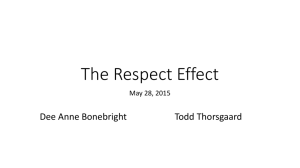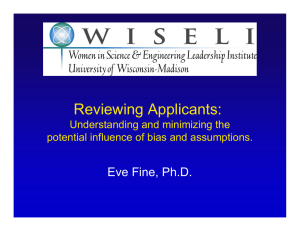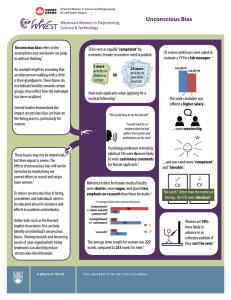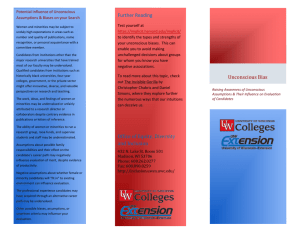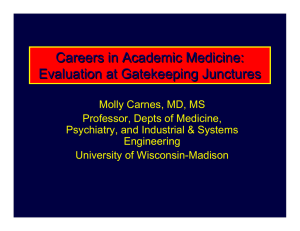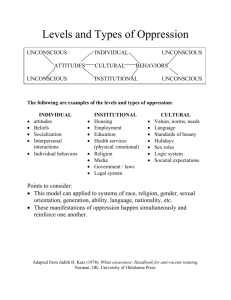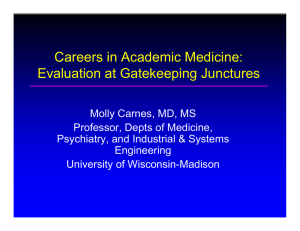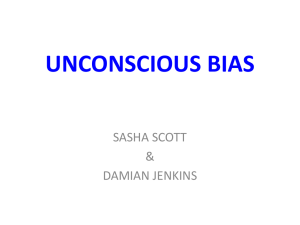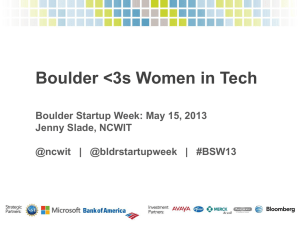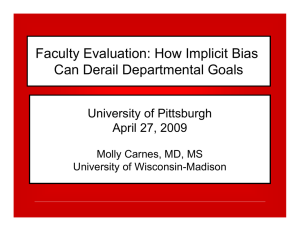Procedures that activate or mitigate gender bias in scientific review
advertisement
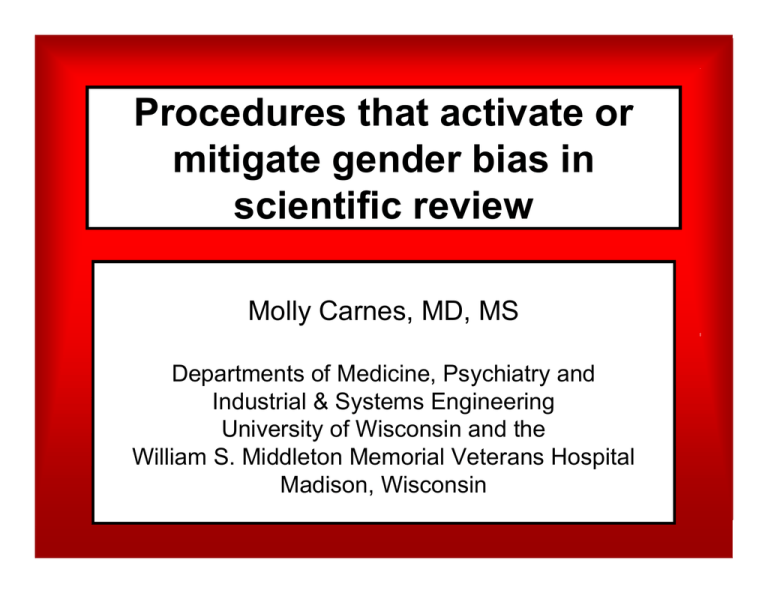
Procedures that activate or mitigate gender bias in scientific review Molly Carnes, MD, MS Departments of Medicine, Psychiatry and Industrial & Systems Engineering University of Wisconsin and the William S. Middleton Memorial Veterans Hospital Madison, Wisconsin What is “unconscious bias” • • • • • • • • • Unconscious bias and assumptions Previously held beliefs about a social category Schemas Stereotypes Mental models Cognitive shortcuts Statistical discrimination Implicit associations Spontaneous trait inference The tendency of our minds to judge individuals based on characteristics (real or imagined) of groups Background on Gender DESCRIPTIVE: How men and women actually behave PRESCRIPTIVE: Unconscious assumptions about the way men and women in the abstract “ought” to behave: – Women: Nurturing, nice, supportive, helpful, sympathetic, dependent = generally less valued in society (i.e. paid for) – Men: Decisive, inventive, strong, forceful, independent, “willing to take risks” = generally more valued RELEVANT POINTS: – Leaders, physicians, scientists, professors: Decisive, inventive, strong, independent – Social penalties for violating prescriptive gender assumptions – Unconscious gender stereotypes are easily and automatically activated and once activated readily applied Consistent story in field and experimental studies over several decades – • Women and the work performed by women receive lower evaluations than men and the work performed by men – even if the work is identical – multiple studies: e.g. Heilman, 2004; Wenneras and Wold, 1997; Steinpreis, 1999 • Sex of the evaluator makes no difference – i.e. both men and women give women lower evaluations – nearly universal • Women are particularly disadvantaged at evaluation points advancing to high authority positions, especially elite leadership positions – multiple studies; e.g. Sczesny et al., 2006 • Women, but not men, who self-promote receive lower evaluations – Several studies; e.g. Rudman, 1998 • Those who think they have no biases provide the most biased evaluations – Uhlmann and Cohen, 2005 • Letters of recommendation for recruited faculty are significantly different for female vs male applicants – Trix and Psenka, 2003 We all have genderbiases (conscious or unconscious) and they would be predicted to disadvantage women in their academic career advancement Conditions which activate gender bias in evaluation to the detriment of women • Time pressure and high cognitive load • Small number of women in applicant pool or review group • Ambiguous performance criteria for traditionally male position (e.g. “potential” “shows leadership”) • “Feminine” appearance or scent (even among men) • Use of abstract rather than concrete language to describe attributes (e.g. “he broke a test tube” “she is clumsy in the lab”) • Semantic priming with gender-linked words Taking an Evidence-Based Approach: Interventions in at least one randomized, controlled study that mitigate bias in evaluation Intervention Example of study Reduced time pressure and cognitive distraction during evaluation Martell RF. J Applied Soc Psychol, 21:1939-60, 1991 Presence of a member of the social category being evaluated Lowery et al. J Pers Soc Psych 81:842, 2001 At least 25% women in the pool being evaluated Heilman ME. Organ Behav Hum Perf 1980; 26: 386-395, 1980 Instruction to try to avoid prejudice in evaluation Blair IV, Banaji MR. J Pers Soc Psychol 70:1142-1163, 1996 Counterstereotype imaging Blair IV, Ma JE, Lenton AP. J Pers Soc Psychol 81: 828-841, 2001 Establishing the value of credentials before any applicant is seen to avoid “redefining” merit Uhlmann and Cohen, Amer Psychol Assoc 16:474-480, 2005 Type 2 translational social science research: can we apply it to academic institutions? • Language activating unconscious genderlinked bias in evaluation through semantic priming? – NIH Director’s Pioneer Award – Tenure criteria • Changing faculty attitudes and behaviors through workshops for search committees NIH Director’s Pioneer Award • First NIH Roadmap initiative to be rolled out • Intended to accelerate innovative research unsupported through traditional NIH funding mechanisms • $500,000/yr for 5 years • None of 9 awarded first round were women • Women: 6/14 second round (43%); 4/13 third round (31%); 4/12 fourth round (25%) Carnes, et al. JWH, 2005 2004 2005+ Characteristics of target scientist and research Risk-taking emphasized: • “exceptional minds willing and able to explore ideas that were considered risky” • “take…risks” • “aggressive risk-taking” • “high risk/high impact research” • “take intellectual risks” • URL includes “highrisk” Emphasis on risk removed: • “pioneering approaches” • “potential to produce an unusually high impact” • “ideas that have the potential for high impact” • “highly innovative” • URL no longer includes “risk” Goals of research to be supported Technological advances highlighted as desirable: • “support the people and projects that will produce tomorrow’s conceptual and technological breakthroughs” Mention of technological breakthroughs removed; human health added: • “encourage highly innovative biomedical research with great potential to lead to significant advances in human health.” “Leader” in tenure criteria • • • • 25 top research academic medical centers Tenure criteria from websites Scanned for “Leader” Also scanned for other Bem Sex Role Inventory male, female, neutral words • Slopes of regressions for annual % faculty who are tenured women x 7 years • “Leader” = OR 6.0 (1.02, 35.37; p=0.04) for slope below median compared to those without Marchant et al. 2007 Words describing stereotypically male traits predominate in tenure criteria • • • • • • • Male Analytical Competitive Defends Independent Individualistic Leadership Risk Med 5.5/school; 2-50 Total 183 Neutral Friendly Helpful Inefficient Truthful Female Sensitive Understanding Yielding 4 schools 3 schools Total 5 Total 3 Teach faculty how to run effective searches Searching for Excellence and Diversity – Workshops for faculty search committees Active learning Principles of adult education Tenets favoring diffusion of innovation and institutional change Introduce research on biases and assumptions Present evidencebased strategies Percent Female, New Tenure-Track Faculty Biological & Physical Sciences 40.0% 30.0% 20.0% 10.0% 17/49 33/89 6/20 21/84 0.0% Participating Departments 2005 2003-2005 Non-Participating Departments 2005 2006 New Hires' Satisfaction* With the Hiring Process Biological & Physical Sciences 70.0% Percent Agree Strongly 60.0% 50.0% 40.0% 30.0% 28/45 29/53 20.0% 39/58 * 19/44 10.0% 0.0% Participating Departments New Hires 2000-2002 (2003 Survey) Non-Participating Departments New Hires 2003-2005 (2006 Survey) * Agree Strongly to the item "I was satisfied with the hiring process overall." The Climate for Faculty of Color is Good Biological & Physical Sciences 90.0% 80.0% 70.0% FOC 60.0% 50.0% ~ 40.0% 30.0% 20.0% 10.0% 0.0% Participating Departments 2004-05 2003 Survey Non-Participating Departments 2004-05 2006 Survey Summary • Gender-linked unconscious biases and assumptions are ubiquitous • These disadvantage women in academic medicine whenever evaluation is required (e.g. receiving awards, tenure) • Evidence from randomized, controlled studies indicates that activation and application of these biases can be mitigated • Our work suggests that exposing faculty to this area of social science research may increase the number of women faculty recruited and appears to change perceptions of departmental climate for faculty of color
